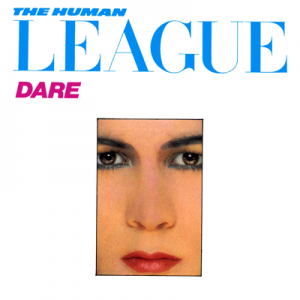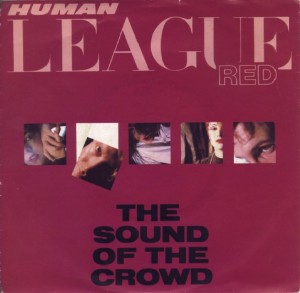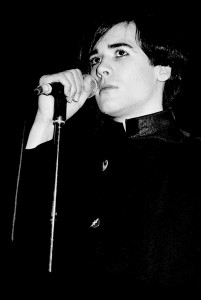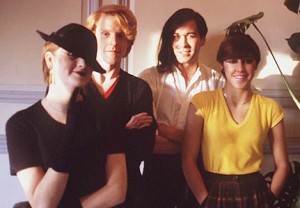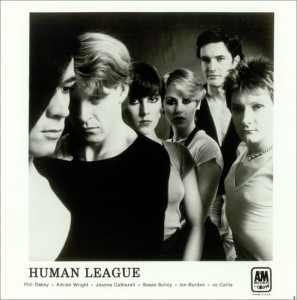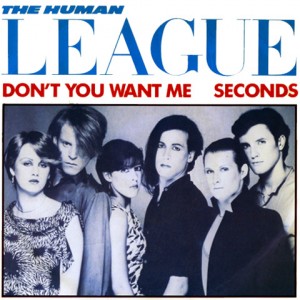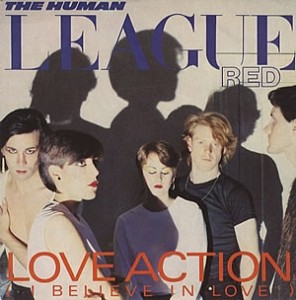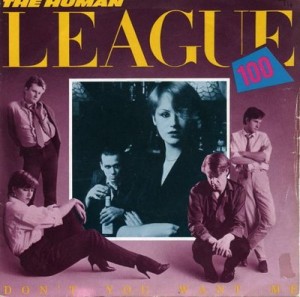BY TYLER BURNS / October 18, 2010
Arrangement Analysis of Dare
“The Things That Dreams Are Made Ofâ€
Intro/Verse 1
• Drums – 1
o Simple beat. Kicks and claps. Claps have reverb. No hats. Tom fills panned wide.
• Synth Bass – 2
o Round and deep. Starts on downbeats. Not overly funky or syncopated.
• Synth Horn (monophonic) – 3
o Commences with the bass. It is played monophonically, so its function is melodic, but clearly outlines the key/implied chords. Has both sustained and active parts. Octave above the vocals. A little reverb. Panned hard right.
• Synth Strings (monophonic) – 4
o This melodic, one-note string part is a response to the synth horn melody. It is panned hard left and has a considerable amount of reverb.
• Vocals
Pre-Chorus 1 (no chord changes)
• Drums – 1
o No beat change. Big tom fill before chorus, which acts as a transitional motif.
• Synth Bass – 2
o Although the chords remain the same as the verse, the bass pattern changes, which lets the listener know this is a different section.
• Synth Lead (monophonic) – 3
o This quick, rhythmic, portamento lead commences on beat one of the Pre-Chorus. It is actually two parts, playing the same note, but one is an octave higher than the other. The higher version is panned hard left, and the lower version is panned hard right. This really helps fill up the stereo spectrum in Pre-Chorus 1 and adds a LOT of rhythmic interest. Right before the chorus, this lead does some crazy portamento, leading into the high notes it sustains during the choruses. This works as a transitional motif.
• Vocals
Chorus 1
• Drums – 1
o No beat change, except that in the first bar delay is added to the handclaps, which acts as a transitional motif. There is also a tom fill before, Verse 2, which acts as a transitional motif.
• Synth Bass – 2
o Very simple and not overly syncopated. Stays mostly on root notes.
• Synth Flute (monophonic) – 3
o This flute sound starts at the beginning of Chorus 1 and sustains the notes Phil Oakey sings…unison reinforcement of vocal melody. Toward the end of each Chorus vocal line, it plays its own simple melody independent of the vocal melody.
• Synth Lead 1 (monophonic) – 4
o This is the same sound from the Pre-Chorus (2 monophonic synth leads playing the same part, one panned hard left an octave higher and the other panned hard right). This line simply sustains a high B, which is the root note of the first chord of the Chorus and is also the first note Phil Oakey sings in the Chorus…unison reinforcement of vocal melody. This sound drops out every two bars to give the chorus a sense of space when Phil Oakey sings, “…the things that dreams are made of.â€
• Synth Lead 2 (monophonic) – 5
o This part is interesting. It plays the thirds of the implied chords and follows the basic pattern of Synth Lead 2, which generally follows the vocal melody (which is root-based). This sound, although mixed quite low, really helps fill out the chorus and adds some much-needed harmony. Although the song is in B Minor, this lead plays a D# the first note of the chorus, changing the first chord of the Chorus to B (major). This sound is an octave lower than Synth Lead 1.
• Vocals
Verse 2
• Drums – 1
o Same beat.
• Synth Bass – 2
o Starts out on the same sound as the rest of the song, and the familiar Verse pattern, but when the vocals come in, the bass sound changes! Sound change.
• Synth Strings (melodic) – 3
o The synth horn sound from Verse 1 is dropped in this Verse 2, making it more sparse. This monophonic string sound remains.
• Vocals
Pre-Chorus 2 (Same as Pre-Chorus 1) (Original bass sound reenters)
Chorus 2 (Same as Chorus 1)
Bridge (drums and vox only)
Chorus 3 (Same as Chorus 1)
Tyler’s Notes
Every synth sound in this song is monophonic. Chords are outlined by different melodic lines. The synth leads reinforce the vocal melody, too, which is extremely effective. Simple transitional motifs with portamento and sustain are extremely effective. The synth bass sound change works wonderfully and is totally unexpected. The original sound returns in the next section.
Max Instruments: Chorus: 5.
Intro/Verse 1
• Drums – 1
o Simple beat. Kicks and snare. Snare has reverb. Straight eighths hats. Tom fills panned wide.
• Synth Bass – 2
o Pedal point on C for the entire Verse except toward the end when the chords change in preparation for the Chorus. Straight eighths. LFO on filter, giving it a slightly sweeped sound.
• Synth Lead 1 (monophonic) – 3
o Panned hard right, playing chord tones.
• Synth Lead 2 (monophonic) – 4
o Panned hard left, playing chord tones.
• Vocals
Instrumental Break
• Drums – 1
o Same beat, tom fills.
• Synth Bass – 2
o Same.
• Synth Piccolo (monophonic) – 4
o Plays the chorus melody of the song.
• Synth Lead 2 (monophonic) – 3
o Panned hard left, harmonizes Synth Piccolo (below the melody).
Chorus 1/2/3
Chorus 1 is the same as the Instrumental Break, except for a synth effect that comes in and plays a sound that has an LFO on the oscillator pitch, sounding similar to a siren. The main vocal melody is, almost always, doubled by the Synth Piccolo…unison reinforcement of vocal melody. Also, at the end of the song, the bass notes change for some of the chords and it gives the song a freshness and also an eeriness. There are also occasional synth sweeps used as transitional motifs.
Tyler’s Notes
This song is quite unusual in that most of it has a pedal point and that the entire chorus vocal melody is more or less backed up by a relentless, astringent synth piccolo sound. It’s a fairly busy mix, especially since the hi-hats and synth bass are both played in straight eighths the entire time. Still, it managed to be a big hit for The Human League and remains an interesting tune. Once again, only monophonic sounds are used, panned wide to fill up the stereo spectrum. Also, there is a lot of unison reinforcement of the vocal melody, as per usual.
Max Instruments: Chorus: 5.
Intro/Verse 1
• Drums – 1
o The snare and kick are simple, but there is a panned tom part going the entire time. Simple synth hi-hat beat comes in a few bars after the bass. No reverb on any of the drums.
• Synth Bass – 2
o Very simple part, not overly syncopated, mostly playing root notes.
• Synth Lead (monophonic) – 3
o Adds further rhythmic interest to the verse. It, more or less, plays the same notes as the vocal melody…unison reinforcement of the vocal melody. Right before the chorus, this sound does a big sweep, which acts as a transitional motif.
• Vocals
Chorus 1
• Drums – 1
o Same drum part, EXCEPT that the hi-hat part now leaves out some notes, allowing for more space. There is also a new synth clappish part panned wide left that happens every 2 bars, independent of the snare.
• Synth Bass – 2
o Again, very simple part, not overly syncopated, mostly playing root notes.
• Synth Lead (monophonic) – 3
o This simple synth lead sustains chord tones (including roots).
• Vocals
Verse 2 (same as Intro/Verse 1)
Chorus 2 (same as Chorus 1)
Verse 3 (instrumental)
• Drums – 1
o The usual.
• Synth Bass – 2
o More stripped down than the previous verses. Just plays at the beginning of each bar.
• Synth Lead (monophonic) – 3
o The usual.
• Synth Pluck (monophonic) – 4
o This plucky/percussive lead doubles the main Synth Lead, but is panned hard right.
• Pad Bass (monophonic) – 5
o Plays root notes, with some fill notes, supporting the Synth Bass.
Chorus 3
• Drums – 1
o The usual.
• Synth Bass – 2
o The usual.
• Synth Lead (monophonic) – 3
o The usual.
• Synth Lead 2 (monophonic) – 4
o This is a very similar (if not the same) sound as the Synth Lead, but plays different chord tones, further outlining the harmony.
• Vocals
Tyler’s Notes
The verses (generally) don’t have sustained parts, while the choruses do…nice contrast. The only change in the drum pattern from verse to chorus is the subtraction of a few hi-hat hits and the addition of a synth clap part panned hard left, which is otherwise independent of the main beat.
The climax of the song is clearly in Verse 3, which is instrumental. We can tell the climax takes place when the huge Pad Bass sound comes in, filling out the stereo spectrum and reinforcing the Synth Bass and when the Synth Pluck reinforces the main Synth Lead. Again, we hear monophonic synth leads in the chorus playing different chord tones, outlining chords.
There is no “bridge properâ€â€¦just an instrumental version of the verse section. This works well.
The synth sweeps at the end of the verse sections work excellently as transitional motifs.
Max Instruments: Verse 3: 5.
Intro
• Pad Bass – 1
o This Pad Bass sounds like a synthesized cello and plays root notes. Not powerful sounding…very smooth and not too much low frequency output.
• Synth Lead – 2
o This sparkly synth lead quickly outlines chords at the beginning of each bar, then drops out. Very long release time.
Chorus 1
• Drums – 1
o Simple beat. Kicks and snare. Quarter-note hats. Snare fills. No reverb on drums.
• Synth Bass – 2
o Huge, fat, round sound. Simple, but funky part. Plays on top of kick hits.
• Pad Bass – 3
o Although very low in the mix, this cello-like synth sound helps fill out the stereo spectrum and reinforces the Synth Bass.
• Synth Strings (monophonic) – 4
o Panned hard left, playing sustained chord tones. Harmonic in function.
• Synth Sequence (monophonic) – 5
o This high-pitched monophonic synth sound is sequenced in straight eighths and plays the same chord tones as the Synth Strings part. Panned hard right. Adds rhythmic interest.
• Vocals
Bridge 1
• Drums – 1
o Same beat, but hats now are straight eighths.
• Synth Bass – 2
o Different sound from Chorus 1. Sound change.
• Bass Octave Double – 3
o This sound is completely unrelated to the Synth Bass sound. It plays the Synth Bass part an octave higher and with a few more notes (embellishments). Panned hard left.
• Synth Sequence 2 – 4
o This high-pitched “sequence†Plays notes E and F continually…straight eighths. These notes are the major 6th and dominant 7th of G (the first chord in this section) and the major 7th and root of F (the second chord in this section).
• Synth Flute (monophonic) – 5
o The first note is the same as the vocal melody, but then plays other chord tones and melodic fills. Both melodic and harmonic in function.
• Vocals
Verse 1
• Drums – 1
o Same beat as Bridge. Tom fills.
• Synth Bass – 2
o Same sound as Chorus 1. Plays on top of kicks.
• Synth Lead – 3
o This sparkly synth lead quickly outlines chords at the beginning of each bar, then drops out. Very long release time. Same sound as in Chorus 1.
• Synth Flute – 4
o Plays a transition melody that also plays on the first beat of Chorus 2. This is a transitional motif.
• Vocals
Chorus 2 (Same as Chorus 1)
Bridge 2 (Same as Bridge 1)
Breakdown (similar to Intro)
• Pad Bass – 1
o Plays root notes, as per usual.
• Synth Lead – 2
o Same as Intro…quickly outlines chords at the beginning of each bar, then drops out. Panned hard left. Very long release time.
• Synth Lead NEW – 3
o We have not heard this sound yet. Is like a half-time version of the Synth Lead’s part, but it incorporates passing tones, as well. Panned center, for attention.
• Synth Lead NEW 2 – 4
o Doubles the Synth Lead NEW part.
Bridge 3 (same as other Bridges, but incorporates a 16th note synth-hat drum pattern and has the Synth Flute melody going throughout. Also, the Synth Flute holds on the first beat of Chorus 3 a LOT longer, making it a very dramatic transition.)
Chorus 3 (same as other choruses)
Bridge 4 (basically the same as Bridge 3, except the beat is now four-on-the floor and there is a “galloping†synth hi-hat addition).
Tyler’s Notes
Wow, what a crazy arrangement! There are 4 bridge sections in this song…unheard of to me otherwise.
There are a lot of little changes in this song, which really make it come alive (but would make it damn near
impossible to duplicate live).
First, I would like to note that, once again, we hear patch change on the Synth Bass sound several times during the course of the song. This is unusual, but works well as the Synth Bass during the bridge is quite powerful.
The sequenced synth sounds in this song add a LOT of rhythmic interest and really help spice things up.
Once again, we hear monophonic melodies playing sustained chord tones, panned hard. For the first time, we hear a three-note synth melody at the beginning of each bar of the verse outlining the implied chords.
Interestingly the Synth Bass Double and the Synth Sequence 2 almost sound like an arpeggio when put together, as they are the same sound, but are in fact two mono parts panned hard left and hard right.
Again, very interesting to hear an embellished synth bass double an octave higher panned hard left (with a different sound). Very effective rhythmically and also helps fill up the stereo spectrum.
The Synth Flute parts really help with the transitions, especially since they play on the first beat of the new sections.
To me, the Pad Bass sound is unnecessary, except in the Intro, where there is no Synth bass. It seems to take up too much of the low end.
Max Instruments: Chorus(es)/Bridge(s): 5.
Verse 1
• Drums – 1
o Kick is four-on-the-floor. Low and high conga part panned hard right. Hats straight 16ths. Snare is standard 2 and 4. Reverb only on congas. There is a synthesized “rattle-snake†percussive sound panned hard right, every odd bar and there is a synthesized “explosive†sound every even bar panned hard left.
• Synth Bass – 2
o Doesn’t start on the downbeat, but starts on the second 8th note, which is unusual for Human League bass lines. This gives the song a slightly Latin/reggae feel, along with the congas.
• Sample and Hold Lead (monophonic) – 3
o This interesting sound dwells on the root note of the first chord (Em) and the third of the second chord (Bm).
• Synth Lead 1 – 4
o This high-pitched lead is panned center for maximum attention. It begins on G, which is the 3rd of Em and hovers around B, the root of Bm. This lead only plays when the vocals are not present
• Synth Lead 2 – 5
o This lead is pitched at the same octave as the vocals. It hovers around the same notes as the Sample and Hold Lead and is panned far right…a perfect counterbalance. While not rhythmically interesting, it helps solidify the implied chords.
• Vocals
Chorus 1
• Drums – 1
o Same.
• Synth Bass – 2
o Very similar to verse, rhythmically.
• Synth Strings (monophonic) – 3
o Panned center. High pitched. Plays the 5ths of the first two chords, which are Em (B) and D (A). Harmonic and melodic in function.
• Synth Lead 3 (monophonic) – 4
o Begins on an E, which is the root of Em, then plays the same notes as the Synth Strings. Effectively doubles the Synth Strings part…unison.
• Synth Lead 4 (monophonic) – 5
o Comes in when Phil sings “Do or die.†Hovers around E, the root of Em and the 2nd of D. Primarily adds rhythmic interest.
• Vocals
Bridge
The bridge is very long and consists of instrumental versions of the verse and chorus sections. There are new synth sounds introduced that we haven’t heard playing different melodies, but structurally, everything is just about the same. Also, the synth strings are played polyphonically during this section, which adds interest, as we haven’t heard ANY polyphonic parts on the record thus far.
Final Chorus (same as Chorus 1)
Tyler’s Notes
The key to this song is rhythmic interest…there is a TON of it! The drum pattern is fairly exotic, although extremely danceable. The synthesized percussive sounds add a lot to the beat, as well. The bass line does not begin on the downbeat of any section, but waits until the second 8th note to begin…Latin/reggae feel. Also, the Sample and Hold Lead during the verses and Synth Lead 4 during the choruses adds rhythmic interest.
Again, the song is mostly comprised of monophonic sounds working together to imply harmony. Most sounds revolve around root notes and fifths, which is very simplistic, but also very effective for solidifying the arrangement. SIMPLICITY!
Max Instruments: Chorus(es): 5(ish).
“Get Carter†(monophonic instrumental)
Intro/Verse 1
• Synth Bass – 1
o Big, round, nearly fully sustained. Fairly simplistic bass line. Hovers around the roots of the initial transposition of the verse chords, Gm and C.
• Synth Strings (monophonic) – 2
o Sustained monophonic strings play the fifth and the root of the initial transposition of the verse chords, D (for Gm) and C (for C).
• Synth Lead (monophonic) – 3
o This large, stereo-sounding lead consists of just two notes, F and E, which play against the Gm and C chord, respectively. The F is the minor 7th against the Gm chord and the E is the major third of the C chord. These notes come in on beat two every two majors.
• Melodic Synth Effect – 4
o I don’t know how to describe this sound, other than it sounds amazing. It sounds like a bunch of notes with delay racing across the stereo spectrum…panning from hard left to hard right. Seems to dwell on the note D, which is the 5th of Gm and the 9th of C. Adds to the surreal, eerie tone of the song. This synth effect also plays on the first beat of the chorus, playing an F#, which is the 3rd of the D chord that begins the chorus. Also, plays on the first beat of Verse 2 after Chorus 1 ends. Therefore, it is a transitional motif.
• Vocals
Chorus
• Drums – 1
o Just a simple, delayed, super thin, Kraftwerk-like synth snare keeps the 6/8 time. Adds distinction to this section.
• Pad Bass – 2
o Absolutely gigantic pad bass sound. Liable to blow out speaker systems. Full sustain. Plays the root notes of the chorus chords.
• Synth Bass – 3
o Played an octave higher than normal and just helps double the melody for the first two notes at the beginning of each measure. Doesn’t sound like a bass sound anymore, just a round, mid-range, synth blip. Unison vocal melody reinforcement.
• Vocals
Verse 2 (same as Verse 1)
Chorus 2
• Drums – 1
o Same.
• Pad Bass – 2
o Same.
• Synth Bass – 3
o Same.
• Synth Lead (monophonic) – 4
o During the second half of Chorus 2, this high-pitched, sustained lead comes in. It begins on A, the 5th of the D chord that starts the chorus. Then it just plays the root notes of the remaining chords: G, F, and Em. Therefore, I’d say its function in more melodic than harmonic. This part is unnecessary, but it reinforces the root-notes.
Tyler’s Notes
This arrangement is wonderfully simplistic. I particularly love the powerful transition from the verses to the choruses marked by the huge Pad Bass sound. The Melodic Synth Effect REALLY helps with the section transitions and helps disguise the huge change in sound from the sparse verses to the ballsy, sustained choruses, back to the verses.
It was also really interesting to hear the Synth Bass playing up one octave in the chorus sections, not sounding at all like a bass sound anymore, and reinforcing the vocal melody. Brilliant. Once again, we hear monophonic leads working together to outline harmony, rather than typical chord-based parts. We also hear a lot of root note reinforcement in the chords and 5ths…almost no thirds. This is very typical for this album, thus far.
Max Instruments: Verses/Chorus 2: 4.
Intro
• Drums – 1
o Kick is four-on-the-floor. Straight eighths mid tom part panned hard right. Snare-ish synth sound on 2 and 4. Rhythmic synth drum fills panned hard left every 4 bars…mostly based on straight eighths.
• Pad Bass – 2
o Big, simple, and fully sustained. Plays root notes.
• Synth Lead 1 (monophonic) – 3
o High-pitched. Fully sustained. Panned hard left, playing D against the G chord (5th) and C# against the A chord (major 3rd.)
• Synth Lead 2 (monophonic) – 4
o Same sound as Synth Lead 1, panned hard right. Plays B and A against the G chord (3rd and 9th) and A against the A chord (root).
Verse 1
• Drums – 1
o Same.
• Pad Bass – 2
o Same
• Synth Lead 3 (polyphonic) – 3
o Hovers around the note A, the 9th of the G chord and the root of the A chord. This is the same note the lead vocal hovers around. Therefore, this sound is a unison vocal melody reinforcement.
• Vocals
Instrumental Interlude (Same as Intro, with one added synth blip)
Verse 2
• Drums – 1
o Same. Has one gunshot percussive synth sound effect.
• Pad Bass – 2
o Same
• Synth Lead 3 (polyphonic) – 3
o Hovers around the note A, the 9th of the G chord and the root of the A chord. This is the same note the lead vocal hovers around. Therefore, this sound is a unison vocal melody reinforcement.
• Synth Lead 1 – 4
o Plays during the vocals for the first time.
• Synth Lead 2 – 5
o (See above.)
• Vocals
Chorus
• Drums – 1
o Same.
• Pad Bass – 2
o Same.
• Synth Lead 1 (monophonic) – 3
o Begins the chorus with the vocals.
• Synth Lead 2 (monophonic) – 4
o (See above.)
• Synth Lead 3 (polyphonic) – 5
o Comes in toward the end of the chorus and plays a new riff against the vocals, still hovering around A.
• Vocals
Bridge (instrumental)
• Drums – 1
o Same.
• Pad Bass – 2
o Same sound, plays new notes, implying new chords.
• Synth Lead 3 (monophonic) – 3
o Plays the chorus melody.
Breakdown (instrumental)
• Drums – 1
o Same.
• Synth Lead 1 (monophonic) – 2
o Same part.
• Synth Lead 2 (monophonic) – 3
o (See above.)
Chorus 2 (same as Chorus 1, but adds a whooshing, melodic synth effect and ends with a random jumble of sounds)
Tyler’s Notes
The synthesized drums sounds in this song REALLY add to this arrangement. The synth snare sounds like a combination of a gunshot and a slow-motion bitch slap. The straight eighths mid tom pattern panned hard right and the rhythmic synth drum fills panned hard left are the driving force of this groove. There needed to be this much percussion because the bass part (Pad Bass) has no rhythmic interest.
Yet again, we hear two monophonic leads panned hard left and hard right playing different chord tones, filling out the harmony.
Interestingly, this is only the second time we hear a polyphonic synth part on Dare, (Synth Lead 3). However, this sound is not played polyphonically the entire time…just at certain times, which gives it an improvisational feel. (Not as “academic†sounding…more in line with punk aesthetics.)
Most of the song is based around just two chords, G and A, which are the IV and V chords, respectively, of D Major. The Bridge implies some different chords, however, which is a nice change.
The ubiquitous Pad Bass drops out during the instrumental Breakdown, which is an effective contrast and gives the ear some rest. This section prepares us for the climax, which, in this case, is Chorus 2.
I’m particularly fond of the end of the song, which is a jumble of synth sounds, playing out of time. The drums also go awry, which is a welcome contrast to the perfectly quantized sound of the rest of the record.
Max Instruments: Verse 2/Choruses: 5
Intro
• Synth Filter Blip 1 (monophonic) – 1
o This “classic†Human League sound gets VIP treatment at the beginning of the song, fully stereo and panning from hard left to hard right. Plays the note G, which is the 11th of Dm (the first chord) and the root of Gm (the second chord).
• System 700 Pitch-to-Voltage Comp (monophonic) – 2
o This highly rhythmic sound was created by triggering a System 700 with a guitar signal. Notationally, it’s like a one-note rhythm guitar part. This part plays three notes. F and D are played against the Dm chord, (the 3rd and root, respectively). G is played against the G chord, which is the root.
Verse 1
• Drums – 1
o Very standard beat. Kick four-on-the-floor. Synthesized snare on 2 and 4. Hats in straight eighths, panned hard right. Synthesized maraca also in straight eighths, panned hard left.
• Synth Bass – 2
o Big, fat, round sound. Simple part playing mostly root notes.
• Percussive Synth Arpeggio (monophonic) – 3
o This high-pitched, very short decay, no sustain, very short release synth arpeggio consists of just two notes: G and D, which are the 11th and root, respectively, of the Dm chord and the root and 5th, respectively, of the G chord. This arpeggio plays 16th notes with plenty of odd rests. Adds a lot of harmonic interest. In stereo.
• Synth Filter Blip 1 (monophonic) – 4
o Same. Volume is much lower and is now in mono. Allows for more room in this mix.
• System 700 Pitch-to-Voltage Comp (monophonic) – 5
o Same. Love the rhythmic interest this part creates.
• Vocals
Interlude 1 (Instrumental)
• Drums – 1
o Same
• Synth Bass – 2
o Same.
• Percussive Synth Arpeggio (monophonic) – 3
o Same
• Synth Filter Blip 1 (monophonic) – 4
o Same.
• System 700 Pitch-to-Voltage Comp (monophonic) – 5
o Same
• Synth Lead 1 (monophonic) – 6
o This catchy, highly rhythmic synth lead dwells on the note B during the Dm chord (the 6th) and on G during the G chord (the root).
Verse 2
• Drums – 1
o Same
• Synth Bass – 2
o Same
• Percussive Synth Arpeggio (monophonic) – 3
o Same
• Synth Filter Blip 1 (monophonic) – 4
o Same.
• System 700 Pitch-to-Voltage Comp (monophonic) – 5
o Same.
• Synth Strings (monophonic) – 6
o High-pitched, fully sustained. Dwells on the note D most of the time, which is the root of Dm and the 5th of G.
• Vocals
Chorus 1
• Drums – 1
o Same, except the hats panned hard right are gone and the maraca sound panned hard left is much louder and more pronounced. Also, there are occasional extra kicks.
• Synth Bass – 2
o Similar part, just based on the root notes different chords (F to G). Also, the bass goes lower than in the verses. (The lowest note in the verses is G…the lowest note in Chorus 1 is F.
• Synth Filter Blip 1 (monophonic) – 3
o Same.
• Synth Lead 2 (monophonic) – 4
o This hollow, unsustained synth lead plays C against the F chord (the 5th) and F and G against the G chord (minor 7th and root).
• Vocals
Interlude 2 (same as Interlude 1)
Bridge
• Drums – 1
o Same as verses/interludes.
• Percussive Synth Arpeggio (monophonic) – 3
o Same.
• Vocals
Chorus 2
• Drums – 1
o Same as Chorus 1.
• Synth Bass – 2
o Same as Chorus 1.
• Synth Filter Blip 1 (monophonic) – 3
o Same as Chorus 1.
• Synth Lead 2 (monophonic) – 4
o Same as Chorus 1.
• Synth Strings (monophonic) – 5
o Dwell on the notes G and F, which are the 9th and root of the F chord, respectively, and the root and minor 7th of the G chord, respectively. Once again, there is a very strong dwelling on the note G.
• Vocals
Interlude 3
• Drums – 1
o Same as Interlude 1.
• Synth Bass – 2
o Same as Interlude 1.
• Percussive Synth Arpeggio (monophonic) – 3
o Same as Interlude 1.
• Synth Filter Blip 1 (monophonic) – 4
o Same.
• Synth Filter Blip 2 (monophonic) – 5
o Same sound as Synth Filter Blip 1, only is playing a melody that hovers around the notes G and D.
• System 700 Pitch-to-Voltage Comp (monophonic) – 6
o Same.
• Synth Lead 1 (monophonic) – 7
Chorus 3 (same as Chorus 2, but adds Synth Lead 1)
• Drums – 1
o Same as Chorus 2.
• Synth Bass – 2
o Same as Chorus 2.
• Percussive Synth Arpeggio (monophonic) – 3
o Same as verses, etc.
• Synth Filter Blip 1 (monophonic) – 4
o Same as Chorus 2.
• Synth Lead 1 (monophonic) – 5
o This is the first time we hear this in a chorus section.
• Synth Lead 2 (monophonic) – 6
o Same as Chorus 2.
• Synth Strings (monophonic) – 7
o Same as Chorus 2.
• System 700 Pitch-to-Voltage Comp – 8
o Comes in after a few bars.
• Vocals
Tyler’s Notes
There are a LOT of rhythmic elements in this song, which is part of the reason it was a huge hit and has since become a dance classic. The drum part is very simplistic, which allows the synth elements have room to be far more rhythmically interesting.
Synth Filter Blip 1, Synth Filter Blip 2, and the System 700 Pitch-to-Voltage Comp are unique, brilliantly programmed sounds. The first sound we hear in the song, Synth Filter Blip 1, is instantly recognizable.
Several of the synth parts seem to dwell on the note G. The G chord is in both the verse and chorus sections.
The Bridge is acapella, except for the Drums and the Percussive Synth Arpeggio, which is a strong contrast to the “fullness†of the rest of the song.
I would argue that there are too many instrumental elements in Chorus 3 (8). It’s distracting and detracts from the catchiness of each element.
Max Instruments: Chorus 3: 8
Interlude 1 (Intro)
• Drums – 1
o Simple kick pattern. Snare is standard 2 and 4. Hats straight 16ths panned hard left. Reverb on snare.
• Synth Bass 1 – 2
o Melodic, fairly simplistic bass line. Not overly syncopated.
• Synth Sequence (monophonic) – 3
o Percussive, straight 16ths. Plays the note C, which is the 3rd of the first chord (Am) and the root of the second chord (C). Panned hard right to compliment the hats that are panned hard left, (which are also in straight 16ths).
• Synth Pad (polyphonic) – 4
o Thick, two note chords. Panned center-left. Could be two monophonic tracks playing two different notes with the same sound, but it’s hard to tell.
Verse 1
• Drums – 1
o Same.
• Synth Bass 2 – 2
o Different bass sound. Sound change. Rounder, less abrasive. Simple pattern that dwells mostly on root notes.
• System 700 Pitch-to-Voltage Comp (monophonic) – 3
o This highly rhythmic sound was created by triggering a System 700 with a guitar signal. Notationally, it sounds like a one-note rhythm guitar part. Plays the notes C and D, which are the 5ths of the two verse chords, F and G, respectively. Panned hard right.
• Chord Riff 1 (polyphonic) – 4
o Quick, punchy, three note chords with no sustain. Panned hard left. Rather than just playing the F and G chords, they play other diatonic chords, as well. Therefore, rather than a harmonic part, these chords act more as a polyphonic melody than anything else…similar to a polyphonic rhythm guitar riff. These chords add rhythmic interest.
• Synth Horn Stabs (polyphonic) – 5
o These two-note stabs add further rhythmic interest and harmonic foundation. Panned center.
Pre-Chorus 1
• Drums – 1
o Same. Big tom fill before Chorus 1.
• Synth Bass 2 – 2
o Similar riff as Verse 1, with different notes. During the second-half of the Pre-Chorus, begins to play straight eighth root notes.
• Chord Riff 2 (polyphonic) – 3
o Quick, punchy chords with no sustain. Straight 8ths. Panned hard left.
• Chord Riff 3 (polyphonic) – 4
o Horn-like stabs playing a very simple pattern WITH sustain, which contrasts Chord Riff 2. Adds rhythmic interest. Panned hard right.
Chorus 1
• Drums – 1
o Same.
• Synth Bass 2 – 2
o Same riff as Verse 1.
• System 700 Pitch-to-Voltage Comp (monophonic) – 3
o Same as Verse 1.
• Synth Lead 1 (monophonic) – 4
o Interesting countermelody to the vocal melody. Hovers around the root notes of the chorus chords, (F and G). The vocal melody also hovers around these root notes. Therefore, Synth Lead 1 is a unison reinforcement of vocal melody
• Chord Riff 4 (polyphonic) – 5
o Hornish. Two note chords. Panned center-ish. Adds some rhythmic interest and a lot of harmonic foundation.
Verse 2 (same as Verse 1)
Pre-Chorus 2 (same as Pre-Chorus 1)
Interlude 2 (same as Interlude 1)
Chorus 3
• Drums – 1
o Same.
• Synth Bass 2 – 2
o Same.
• System 700 Pitch-to-Voltage Comp (monophonic) – 3
o Same.
• Synth Lead 1 (monophonic) – 4
o Same.
• Chord Riff 4 (polyphonic) – 5
o Same.
• Synth Horn Stabs (polyphonic) – 6
o Only heard in the verse until this point. Helps the song climax.
Tyler’s Notes
Like “Love Action,†(which was also a single), “Don’t You Want Me,†implements a quick, rhythmic sequence from the System 700 triggered by a rhythm guitar part. Along with the straight sixteenth hi-hat part panned hard the other way, this arrangement has a lot of rhythmic impetus. Without the brilliant rhythm parts, this song still would have been a huge pop single, but I doubt it would have become a dance classic. RHYTHM IS THE POWER!
Interestingly, we hear several different polyphonic parts in this song, which is very unusual for Dare. These polyphonic parts give “Don’t You Want Me†a more poppy feel than the rest of the album.
Max Instruments: Chorus 3: 6
Summary
• To help distinguish different song sections, make small changes to the lesser drum elements (hi-hats, open hi-hats, maracas, shakers, toms, congas, claps, claves, synthesized drums).
o A little change goes a LONG way when it comes to drums.
o Changing the kick and snare parts (except for fills) is GENERALLY not recommended…disrups the rhythmic flow of the groove.
o If you choose to use the same drum pattern for the entire song, try adding delay to one of the drum elements just for a beat or two at the beginning of a new section to help indicate a section change.
• For songs that don’t have complex chords or quick chord changes, imply the harmony with two different monophonic synth lines, panned hard left and hard right, each playing different chord tones.
o This is more creative than polyphonic chord parts and adds a melodic element to the harmony.
o These monophonic synth lines should dwell on one chord tone, but can play other notes intermittently.
o When a vocal melody is active, the supporting harmonies and melodies should be relatively inactive and sustained. When a vocal melody is sustained (or resting), supporting melodies and harmonies can be more active and have more movement.
o Panning two mono elements hard left and hard right creates an extremely WIDE stereo image!
• Dance songs benefit from a sundry of rhythmic elements. RHYTHM IS THE POWER!
• There is never a need to have more than six instrumental elements (including drums and vocal harmonies) in an arrangement at any given time. Verses should, generally, contain 3-4 elements and choruses should, generally, contain 4-5 elements and OCCASSIONALLY contain 6 elements.
• Transitional motifs help unify section changes.
o Transitional motifs include: drum fills, synth swipes, sustained melodies or chords that fade in and reach their max volume or filter openness right before the section change and then abruptly cut off on the first beat of the new section, synth fx, portamento synth leads, and existing synth melodies that end on the first beat of the next section.
• Changing synth bass sounds for each section can be an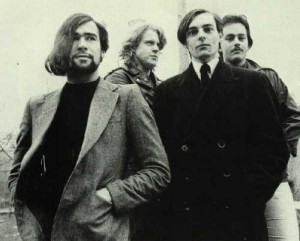 extremely effective element of contrast. Best used sparingly.
extremely effective element of contrast. Best used sparingly.
• Simple melodies that dwell on the roots and fifths of chords are often the strongest.
• Reinforcing the lead vocals with synth melodies can be extremely effective. Oftentimes, only the first note needs to be reinforced, and then the synth melody can be independent of the vocal melody.
• Vocal melodies that dwell on chord roots are very strong and oftentimes catchier than 3rds, 5ths, or other intervals.
• It is extremely helpful to have at least one non-bass instrumental element reinforce the root note of each chord.
• Try recording one melody as two monophonic parts, each an octave apart. Pan each of these elements hard left and hard right. Now you have an extremely full-sounding melodic element that helps fill out the stereo spectrum.
• It is extremely effective to leave the middle register of a song (where big, 5-6 note pads generally sit) completely free of instrumental frequencies. (This is where the vocal frequencies reside, so it should not be cluttered with similar frequencies from instruments.)
o Therefore, pads should never contain notes below C3 unless there is no synth bass present. Voice your pads as two or three notes played high up (right hand only), not as 5-6 notes (using both hands).
o Also, most melodic elements should be at least one octave higher than the vocals.
• Reharmonizing a few chords in the last section of a song can help a repetitive melody sound fresh and new. Often the easiest way to do this is just to change the bass note.
• Arranging one section with a typical synth bass part and another section with a sustained “pad bass†helps sections contrast. This technique conjures drama and emotion. However, don’t necessarily throw out the synth bass sound when the pad bass is playing. Try playing the synth bass sound up an octave or two and have it intermittently reinforce vocal melodies or other synth melodies. This will keep the arrangement simple and keep the synth bass sound relevant, even though it is not supplying the low frequencies.
• Try doubling melodies with two different types of sounds…one plucky and percussive, the other with a slow attack and full sustain.
• Try to make one section of a song full of blippy, unsustained sounds and another section filled with sustained sounds. Contrast, contrast, contrast.
• Instead of playing a polyphonic chord part, try outlining (implying) a chord with three really quick melodic notes (like a blippy arpeggio). Try this with a long release, to give a sustained “chord-ish†feel.
• Try doubling the bass line with a different sound an octave or two higher. Feel free to pan hard left or right. Try adding extra notes to this melodic bass double (embellishments or passing tones, for example).
o This technique makes the bass line sound more sophisticated, (though it obviously doesn’t change the actual bass line at all).
• Monophonic melodic sequences of straight eighths panned hard left or hard right add rhythmic interest. Try contrasting with straight eighth hats panned hard the other way.
• For sections using sustained bass (pad bass) that only plays root notes and has no rhythmic interest, the drum part needs to be more complicated rhythmically to maintain interest.
• Ending songs with a jumble of synth sounds and drum parts that are out of time can be an effective contrast against a perfect-sounding, quantized arrangement.
• Polyphonic riffs don’t have to be entirely polyphonic. Try incorporating some single notes…makes it sound more improvisational.
• If you manage to create a sound that is special, unique, and instantly recognizable, make sure to give it a solo section in the song, where we can hear it in all its isolated beauty. Ideal sections are intros and bridges.
• Acapella sections (generally with drums) are great for contrast. Try writing an acapella bridge.
• It is wise to incorporate synthesized drum sounds in your drum parts (if you’re using sampled drums or typical 808/909 sounds).
• Two-note percussive (and melodic) arpeggios with very short decays, no sustain, and a very short release time are excellent complements to your drum parts. The best notes to choose are generally the root and the 5th of the key the song is in. For example, it would be wise to use a percussive arpeggio with the notes C and G in the key of C Major. These notes fit well with most chords in C Major. The root and the 11th are also good choices. In the key of C Major, these notes are C and F.
